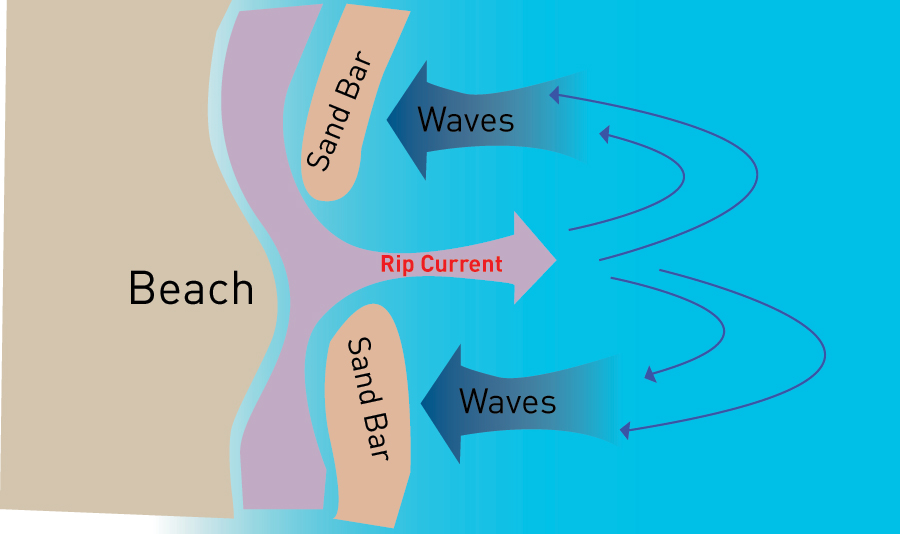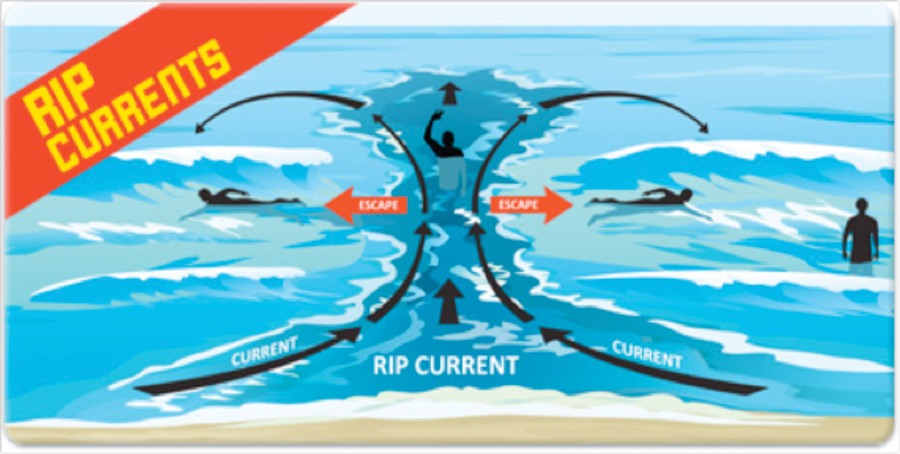Outdoor Safety
Keeping Safe at the BeachQ. How safe are Australian beaches?
A. Going to the beach is a popular pastime in Australia, but it can be a dangerous place. On average, one person has drowned every week at an Australian beach for the last 5 years and on average 10 people are rescued every day. International tourists and those who are unfamiliar with the beach are at a greater risk of drowning.
Q. What hazards are there at Australian beaches?
A. There are a number of dangers at Australian beaches. These include: rips, tidal and runback currents, waves, drop offs, sand bars, marine stingers, submerged objects, other people and surf craft.
Q. What is a rip and how do I recognise one?
A. Rips are one of the most common hazards at Australian beaches. Rips are fast-flowing currents where the water flows out in the direction that causes the least resistance. Recognising a rip is the first step in being able to avoid being caught in one. To recognise a rip look for discoloured water, brown in colour due to sand being stirred from the bottom, foam on the surface that extends beyond the breaking waves, a ripple appearance when the water around is generally calm, debris floating with the current and waves breaking larger and further out on both sides of the rip.
Q. What do I do if I’m caught in a rip?
A. If you are caught in a rip, do not panic, remain calm. If you are a poor or non-swimmer then you should go with the rip, float and wave and wait to be rescued. If you are a weak or tired swimmer then you should swim parallel to the shore and then return to shore when conditions allow. If you are a strong swimmer you should either swim parallel to the shore or angle your body diagonally across the current, returning to the shore through the breaking waves.
Q. What can I do to keep myself safe at the beach?
A. When at the beach you should always swim between the red and yellow flags. Never swim at unpatrolled beaches and never swim alone. If you do get into trouble, don’t panic, float and wave and wait to be rescued. Be aware of your limitations and evaluate your skills and fitness at a safe environment such as a public pool prior to swimming at the beach, to make sure you’re physically capable of swimming in the surf. Refrain from drinking alcohol before swimming and never swim at night.
Q. I’m worried about being stung at the beach, what do I do?
A. To keep yourself safe, wearing a stinger suit (neck to ankles) or a rash vest, swim in areas which are surrounded by stinger nets, heed warning signs, swim at patrolled beaches, use caution entering the water, avoid swimming at beaches during stinger season if possible (usually September to May) and supervise children as they are more vulnerable to stings.
- Children should be supervised at all times at the beach and near water, no matter what age they are. However, it is important to teach children safety practices so that they know how to prevent a situation occurring.
- Water safety is about using and practising common sense. Encourage sensible habits in your children so that it becomes a natural action or reaction. Always show the correct way of keeping safe in the water by setting a good example. It is important to avoid being contradictory.
Download more information (PDF)
SURF SAFETY
Always swim between the red and yellow flags. That is where the surf lifesavers patrol and can help if you have problems in the surf. If there are no flags, ask a lifesaver to show you the safest place to swim. If there is no lifesaver, do not enter the water. To locate a patrolled beach near you, visit www.beachsafe.org.au
Another important point is to train yourself and your children to recognise the hazards at the beach, such as rips. This chapter is designed to help people understand the processes behind how the hazards form and how to cope with them should they find themselves in difficulty.
RIPS
What is a rip current? A rip current, generally referred to as a rip, is a moving current of water, which can be strong and fast flowing. It will usually start near the shoreline and flow away from the beach. For an animated description and further information, please visit http://www.ripcurrents.com.au/About-Rip-Currents/What-is-a-Rip-Current.aspx
Why are rip currents dangerous?
Rips are the number one hazard on Australia’s beaches, and are the cause of most rescues and many drowning deaths every year. They can drag swimmers away from the beach, and often result in drowning when swimmers attempt to fight the current, become exhausted and panic. Rips can also be deadly for non-swimmers as a person standing in waist deep water can be dragged out into deeper waters where they can drown if they are unable to swim and are not wearing a flotation device.
How can I spot a Rip?
The first thing to note is that rip currents can be difficult to identify. Surf Lifesavers and Lifeguards receive training to be able to identify them and use them which is why the best place to swim is between the red and yellow flags. One or more of the following natural features may alert you to the presence of a rip. For an animated description and further information, please visit http://www.ripcurrents.com.au/Rip-Currents-Safety/How-to-spot-a-Rip-Current.aspx
- Darker water, indicating deeper water.
- Murky brown water caused by sand stirred up by faster moving water.
- A choppy or rippled look, when the water around is generally calm.
- In large surf, a smoother surface with much smaller waves (a calm patch).

Common Rip Locations
Rips can occur anywhere on a beach, but are common:
- Around headlands, jetty’s, break walls.
- Around rocks.
- In front of rivers, creeks and storm water outlets.
What do I do if I get caught in a Rip?
- Avoid rip currents by always swimming between the red and yellow flags.
- To escape a rip current, swim parallel to the beach.
- For assistance, stay calm, float and raise an arm to attract attention.
- Conserve your energy by using waves to assist you back to the beach.

Beach Safety for Visitors to Australian Beaches
1. Always swim between the red and yellow flags (www.beachsafe.org.au).
2. Read the safety signs.
3. Ask a Lifesaver/Lifeguard for safety advice.
4. Swim with a friend.
5. If you need help, stay calm and attract attention.
Why is it important to be beachsafe?
The beach is one of Australia’s most important and enjoyable features. Everyone will visit the beach at least once in their life and sometimes as often once a week or more. Unfortunately the beach has hidden dangers that you may not be aware of, so it’s
important that you follow some simple tips so you can enjoy the beach safely.
Information reproduced with the permission of Surf Lifesaving NSW – www.surflifesaving.com.au



